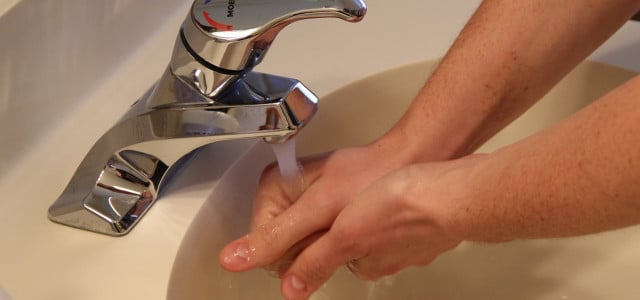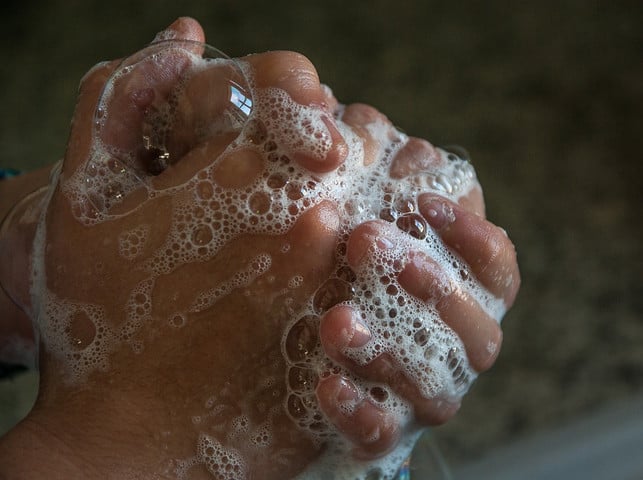
Washing your hands properly is important because thorough washing can prevent infection with coronaviruses. Here you can find out how to get your hands really clean.
![]()
In everyday life, our hands touch doorknobs, keyboards, handles, raw food – and other people. So there are quite a few chances of contact with pathogens, especially during the cold season.
According to the Federal Center for Health Education (BZgA), around 80 percent of infectious diseases are transmitted via hands.
The pathogens can easily get into our bodies through everything we touch, on our hands and through the mucous membranes of our eyes, nose and mouth.
Common sources of germs:
- public transportation
- Supermarkets and other shops
- Shake hands
- Doctor’s waiting room
- Daycare centers and schools
By washing our hands correctly and thoroughly, we can reduce the risk of infection many times over.
The most common mistake: washing your hands too briefly

Since we cannot see the germs and pathogens, it is particularly important to wash your hands long enough, even if they already look clean. It takes at least 20 seconds to remove most germs from your hands – about as long as it takes to hum “Happy Birthday” twice. If your hands are very dirty, it is better to allow 30 seconds or longer. According to a survey by the BZgA, more than 50 percent of those surveyed wash their hands too little.
-
Soaping: To clean your hands properly, you should soap them very thoroughly and, above all, use enough soap. First rinse your hands briefly with clean water and then distribute the soap evenly. Then you can turn off the water and lather the soap thoroughly. The back of the hand and the spaces between the fingers in particular are often neglected. Don’t forget your thumbs and fingernails too! Germs can quickly accumulate, especially under the fingernails. If you want to be very thorough or need to remove coarse dirt, you can also clean your nails with a nail brush. Soap your hands for at least 10 seconds.
-
Rinse: Now rinse your hands with clean water. You should also be thorough here. Allow another 10 seconds to rinse so that your hands are really clean and as germ-free as possible. If you wash your hands in a public toilet, it is best to close the tap with your elbow or a disposable towel – so that the next germs don’t land on your fingers.
-
Drying: Since pathogens multiply particularly well in a moist environment, you should dry your hands thoroughly. When drying, the friction of the towel also removes germs that are still attached to the hands, according to the Federal Institute for Public Health (BIÖG).
Tip: To wash your hands long enough, you can listen to your favorite song. An online tool generates free instructions with the lyrics: “Wash Your Lyrics”: song generator for washing your hands properly
When to wash your hands
It is a must when coming home, according to BIÖG. Other situations in which going to the sink is recommended:
- before meals
- before touching medication
- before and after contact with sick people or treating wounds
- before and after preparing food
- after going to the toilet
- after blowing your nose, coughing or sneezing
- after contact with waste, animals or animal feed
What else you should know about washing your hands

From the supposedly right water temperature to disinfecting your hands, we have a few tips:
-
Water temperature: The temperature of the water plays no role in eliminating germs. So washing your hands with cold water is just as effective.
-
Soap: Although some pathogens can be removed from the skin without soap, washing with soap is significantly more effective. The soap removes the microorganisms from the oily film on the skin, which is not possible with just plain water.
-
Disinfect hands: Small plastic bottles for disinfecting hands can now be bought everywhere. However, studies have shown that disinfectant wipes and antibacterial additives in soaps do not have any increased effect. Even normal hand washing removes 90 to 99 percent of all germs. So the bottles and wipes just create a lot of unnecessary waste. If you don’t work in a hospital and are confronted with an increased risk of infection every day, soap and water are enough.
To avoid putting unnecessary strain on your hands from washing your hands a lot, you should use organic soap and organic hand cream. This also helps against dry heating and cold winter air.
With material from dpa.
German version available: Hand Washing Steps: Doing It Right
Read more on Techzle\.com:
- Washing towels: This is what you should keep in mind
- Hand peeling: recipes for well-groomed hands
- Make your own cosmetics: recipes for creams, shampoos, soap and more
** marked with ** or orange underlined Links to sources of supply are partly partner links: If you buy here, you are actively supporting Techzle\.com, because we then receive a small part of the sales proceeds. More info.
You might also be interested in these articles
-
Saving plastic made easy – shop sustainably with these products
-
Detergent compartment full of water? You should do that
-
8 clever hacks that make cleaning easier
-
Problem microplastics and polymers – these cleaning products are free of them
-
Turn off the lights or leave them on: Which saves more energy?
-
Clean with warm or cold water? This applies to home remedies and other cleaners
-
Brushing in the right order: Follow these rules
-
Frost drying: This is why your laundry will dry outside when the temperature is below zero
-
Discover 9 snacks & recipe ideas for at home and on the go